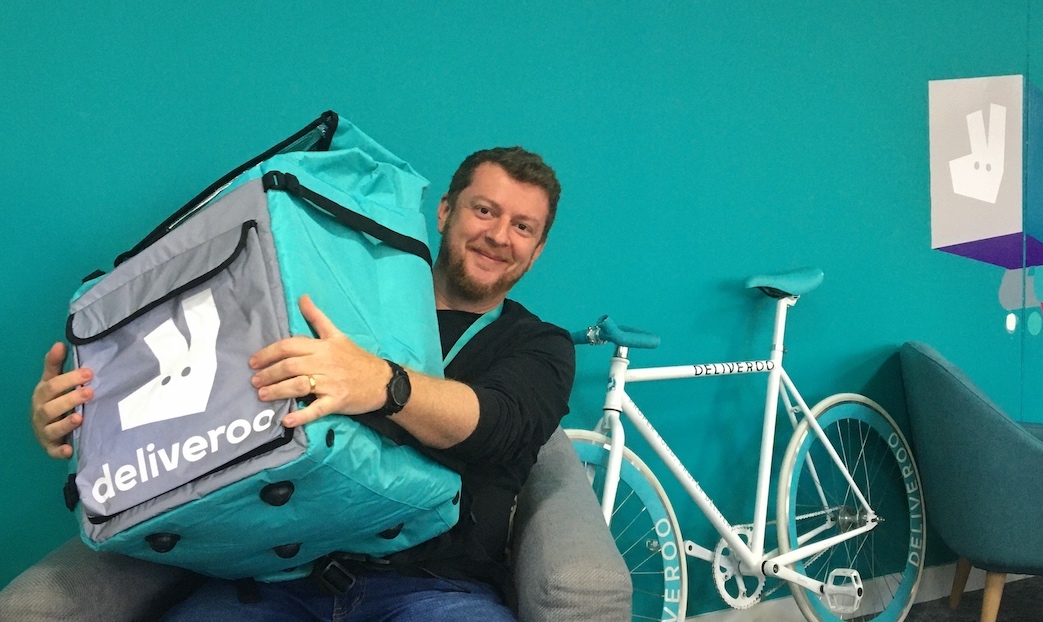How Deliveroo made training a natural part of the job using TalentLMS

About Deliveroo
Deliveroo is a food tech company that connects customers with a wide range of restaurants, convenience stores, and supermarkets so they can get their food delivered on-demand. Founded in the UK in 2013, Deliveroo today works with more than 100,000 restaurants in countries all over the world, including the UK, Ireland, Australia, Italy, Spain, Belgium, Netherlands, France, Hong Kong, Singapore, and the United Arab Emirates.
We spoke with Marcus Verri, Deliveroo’s global sales training manager, to discuss what it feels like to train various distributed teams in a fast-paced environment. And Marcus was clear from the beginning:
“My goal is to provide employees with the resources they need, whenever they need them, so they can be successful at their jobs.”
Not an easy feat when you have to train around 500 employees in different markets.

The challenge: making training more than a box to tick
Marcus was determined to build training that’s meaningful to his teams. To equip and empower them so they’re confident when they are pitching products or talking about the value proposition of Deliveroo. And, that was something training could help with. Except, not the training that was in place.
It seemed like interaction — or the lack of it — was the missing puzzle piece.
“Our training was one-hour Google Meet sessions with hundreds of people connected. No interaction, no participation of the audience, and no follow-up whatsoever. No reporting, and for sure, no performance, no assessments, or anything like that.”
Plus, different markets were using different training tools — or, in some cases, no tools at all. This means that employees didn’t get consistent training. Having one source of truth would help them find what they’re looking for immediately.
Marcus was already on the lookout for better training solutions until the world turned upside down.
How the pandemic changed training at Deliveroo
In one way or another, everyone has been impacted by the COVID-19 outbreak in 2020. The food industry has, undoubtedly, been one of those hit the hardest. The lockdown forced restaurants to close or operate under strict social distancing guidelines. So, lots of them turned to delivery services. Some, for the very first time.
For Deliveroo, this meant they had to onboard new restaurants that were unfamiliar with food delivery. And they had to do so quickly. Also, as Marcus says, Deliveroo started creating a bunch of new projects, products, and services aiming to offer financial support for restaurants and help them thrive during the crisis. Their sales teams needed to know about all these initiatives.
But how? Until the crisis hit, they’d use Slack messages, Workplace Posts, or emails to inform teams about such projects. According to Marcus, though, they were not effective because: “This is communication, not necessarily training.”
Marcus already knew he needed a learning management system to provide consistent training to all teams. The pandemic created an even higher urgency. The training content should be prompt and easily accessible to everyone, so Marcus decided to not waste another day before he found the LMS that could deliver the training his teams needed.
Why TalentLMS?
Ease of use was the number one criterion for picking an LMS due to the urgent training needs the pandemic caused Deliveroo. And that was exactly what drove Marcus to TalentLMS.
“One day, as I was working from home during the lockdown, my wife heard that I was looking to set up a new LMS as soon as possible. A few hours later she came to me and said we should probably pick TalentLMS. I asked her why. ‘Because I’ve already started using it.’
Indeed, she had already created a portal just like the one we have at Deliveroo with the same layout, the same colors, and the same look and feel. And she doesn’t even work in training. It looked amazing!”
Once Marcus tested that TalentLMS supported the functionality he wanted, he presented the solution to his leadership. He quickly got the green light, as the pricing was attractive, and two days later he rolled out the first courses.
The engagement was pretty high from the get-go. In April alone, there were over 600 course completions. “You can tell that our teams were waiting for that for a long time. They were expecting to have one source of truth, to find quality content and actually manage their learning, and go back to the system in case they want to find it.”
But it’s not just the learners who find TalentLMS easy to use. “The admin side is really intuitive, really user-friendly, really fast.” For Marcus, who manages the platform, it’s easy to upload content, add users, and create and organize groups.
And then, there’s TalentLibrary™, too. A real time-saver according to Marcus. As the only admin for more than 500 learners, he values the off-the-shelf training courses that come with TalentLMS.
“I need scalable solutions. There’s no way I can produce the content you have. For example, on my own, it would take me several months.”
Sign up for a forever-free account. No credit card required.
How TalentLMS fits into Deliveroo’s overall training strategy
The function of training and Marcus’ strategy at Deliveroo, is to help people work better, not add extra work. He uses a mountain-climbing metaphor to illustrate his point.
“[My teams] aren’t here to train. They’re not here to learn. They’re here to work and to bring results, and I have to support them as they need. I picture this as if they are climbing a mountain, and they need to get to the top. I can be the right tools, or I just can just be rocks in their backpacks to bring them down, to make them stop working. So I need to be the right tools.”
For this vision of successful training to become a reality, Marcus relies on 3 pillars.
1. Understanding his teams’ routines
Marcus starts his process by understanding what kind of resources his teams need, and when they need them. And that goes beyond the necessary training employees should get when they’re hired. After that, it’s about learning what challenges employees face on the job and building training around those exact challenges.
“If I’m not adding value I’m just the rocks in the backpack. So what I need to do is to provide quality content that they can actually use. It really needs to be practical. They can use the content right after they finish training.”
2. Making training a natural part of what they do
How do they make sure that training is a natural part of employees’ day-to-day, and not an extra part of it? “I don’t believe that people will learn when I want them to learn. I prefer for them to engage with training because of the relevance of the content more than because they have to. So, I need to make resources available and easy to access whenever they need to.”
According to Marcus, microlearning helps in this case. Instead of having long training sessions that force people to stop their work for hours, he opts for smaller chunks of training. For example, he breaks down a one-hour training module into five or six parts, so people feel that they’re progressing. This way, it’s also easier to come back and review the information they need.
3. Putting TalentLMS into action
As Marcus puts it, his role is not to deliver training, but to deliver structure, standards, and value to his teams. Technology is the facilitator here. And that technology needs to help him deliver training in the smoothest possible way.
Employees need to find answers to their questions inside the training platform. Local markets could have their own unique challenges that are not relevant to another market. Managers might want to recommend specific courses after completing the performance reviews of their team members. Or, unexpected events, like a pandemic, could create new, urgent training needs.
The key in all these scenarios is to have one single place where people can pick training that’s relevant and useful. Once Marcus saw that TalentLMS was able to be that source of truth, he made TalentLMS the official global sales training system. The result is Roo Commercial Academy — a space dedicated to each team’s training needs.
“People really like the way it works. And they find it easy. I actually did not have to answer a single support call, so they did not have problems using TalentLMS.”

What success looks like
1
admin handling it all
2
days to roll out courses
500
employees learning
600
course completions/mo
30%
drop in sign-up time
“That’s how I know our training is successful.” – Marcus Verri
Deliveroo & TalentLMS: Matching training with business results
The initial feedback after implementing TalentLMS was positive, with people signing into the platform and completing courses. And that’s a good first sign. But what’s the impact of training on people’s day-to-day work?
You can tell if training is successful, according to Marcus, when you see people changing their behaviors at work and teams reaching their KPIs. For example, instead of his salespeople jumping in on a call with a potential customer, they now use training material to prepare themselves first. They go to the product training inside TalentLMS, review all the information, and, as a result, engage and interact better with customers.
Numbers prove the story correct: “Since we launched TalentLMS, the number of calls from salespeople and account managers with doubts and questions about products, systems, and processes has decreased.” That happens because they have one place to go and look for the answers they need, at the time they need them. And then they can focus on their actual work.
When it comes to KPIs, Marcus explains that, at Deliveroo, they look at both individual performance and the bigger picture. Their strategy is to create content that’s relevant to business goals. And then measure if people and teams reached those goals. For example, one of their goals is to sign up restaurants faster.
“This can happen if salespeople are feeling confident in talking about the products, are addressing the right questions to customers, and are closing their calls in a better way. So this is the kind of stuff that I teach them to do. And the sign-up time decreased by 30%. That’s how I know our training is successful.”
For Deliveroo, that’s the bottom line of training. It’s not a perk, it’s not a box to tick, it’s not something independent from the work routine. It’s the tool that helps people get better at their jobs.
As Marcus puts it: “The tip here is to not force training on people, just understand how they need to learn, where they need to learn, and why they need to learn these things. And try to be a part of what they normally do.”
For training that fits into the natural flow of work
Sign up for a forever-free account. No credit card required.